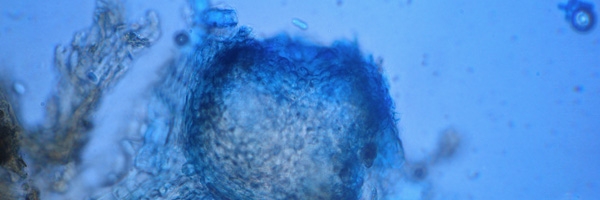
Didymella bryoniae (Fuckel) Rehm (1881)*
Gummy stem blight
Black rots on fruits
- classification : Fungi, Ascomycota, Dothideomycetes, Pleosporomycetidae, Pleosporales, Incertae sedis
- anamorphe: Phoma cucurbitacearum (Fr.) Sacc., (1884)
- synonymies : Didymella melonis Pass., (1891) ; Ascochyta cucumis Fautrey & Roum., (1891) ; Mycosphaerella citrullina (C.O. Sm.) Grossenb., (1909) ; Mycosphaerella melonis (Pass.) W.F. Chiu & J.C. Walker, (1949) ; Cercospora citrullina Cook, Grevilla (1883)...
- English names: Gummy stem blight *, Black rot
* The gummy canker of Cucurbitaceae is not caused by a single fungus as has long been believed, but by at least three:
- Staganosporopsis cucurbitacearum (syn. Didymella bryoniae ),
- Staganosporopsis citrulli ,
- and Staganosporopsis dried .
These 3 species reveal a range of hosts common in Cucurbitaceae ( S. caricae also attacks papaya), but their global distributions appear to be different. It would be advisable to identify more precisely the nature of the species or species prevalent in France.
Note that other fungi belonging to the genus Phoma, such as P. exigua , have also been associated with the symptoms of "Gummy stem blight" in the United States in particular.
The first manifestations of Didymella bryoniae on cucurbits were observed in 1891 in Europe (France and Italy) and the United States. Currently, this fungus is very widespread on all continents and in many countries, especially in tropical and subtropical production areas, but also in more temperate regions. It affects many cucurbits grown in open fields or under cover, especially watermelon, melon, cucumber, winter squash and pumpkins. It is also reported on zucchini, cristophine, calabash, bitter melon or bitter melon, Luffa aegyptiaca ...
This fungus is capable of attacking all the aerial organs of cucurbits (leaves, stems and fruits) causing two main symptoms: more or less gummy stem cankers and / or black rot of the fruits.
Gummy cankers on stems have been reported in a large number of countries , for example posing a major threat to melon crops in certain production areas in the United States. The same is true of watermelon ( Citrullus lanatus ) around the world, particularly in Brazil.
Note that D. bryoniae , in this form, was also associated with a high frequency with the symptoms of sudden death of melon in Honduras in 2009. Very serious in Brazil on this same species, its cankers on stems would have been responsible for mortalities fluctuating between 40 and 100% of plants.
Black rot of fruit is also a very common disease; its impact is especially remarkable on cucumbers during cultivation and storage, and on pumpkins and squash which are often kept for long months in winter. Note that this disease is a serious threat to the pumpkin industry in the United States.
D. bryoniae has been present in France for many years. In our country, this fungus has long found favorable conditions for its development only under shelter, because it particularly likes the hot and humid climates of these cultural contexts. It therefore only represented a real danger for cucumber crops, although it could also be observed on melon, zucchini and squash. The situation has changed somewhat in recent years as significant attacks have been observed, particularly on melon stems in the open field in western France.





